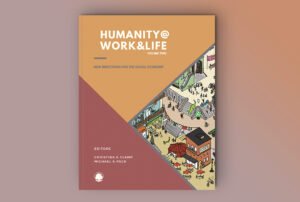
It’s not often that a body of work comes along that makes us ask big questions about the nonprofit sector. Claire Dunning’s new book, Nonprofit Neighborhoods, is one. In it, she not only traces the development of the nonprofit sector. She anchors the sector to one key observation: it was created to offset demands for democracy, particularly by people of color. And that is one big indictment.
“The formal engagement of neighborhood-based nonprofits in urban governance constitutes one of the most profound, if hidden, transformations in the United States over the second half of the twentieth century.”
The title of the book belies the scope of inquiry—Dunning makes the case that using nonprofits as a “tool for addressing urban problems” has led to a form of “urban governance” that uses private organizations to fulfill public, democratic rights.
She writes, “The formal engagement of neighborhood-based nonprofits in urban governance constitutes one of the most profound, if hidden, transformations in the United States over the second half of the twentieth century.”1
The Dawn of the Nonprofit Sector
Dunning begins the history of the nonprofit sector in the 1960s, when protests against discrimination prompted political leaders to look for solutions to persistent poverty. However, Dunning notes, “The idea of working, either directly or indirectly, with private nonprofit entities was not new in the 1960s, but the decade did mark a pivot in a longer trend.”
The vehicle for the development of nonprofit infrastructure was government grants, beginning with President Lyndon B. Johnson’s War on Poverty, which “expanded individual benefits related to health, education, and welfare and doubled down on the idea of working with nonprofit organizations.”2
However, as the federal government increased financial support of urban centers, it also privatized what should have been a public response to political exclusion. Dunning smartly points out that this approach turned rights into privilege. She writes, “Almost by definition, a grant exists as a privilege to be won rather than an obligation to be fulfilled.”3
Furthermore, this approach obscured the need for structural change. Dunning writes,
As neighborhoods nonprofits mediated, for some, access to public goods and services, participation, and representation, they also facilitated a form of privatized inclusion, simultaneously making urban governance more decentralized, diverse, and participatory, and more insulated from the structural changes African Americans and Latinx residents had been calling for.4
Moreover, with this approach the federal government instituted grantmaking as an expression of power. For, as the book outlines, the dictates of Requests for Proposals shaped the development of not only nonprofits, but urban governance. And over time, private foundations emerged and issued grants in a similar way.5 Dunning writes, “The power of grantmaking was the ability to set priorities, demand information, assess budgets, and define time horizons for change.”6
Nonprofits developed as extremely limited alternatives to government.
The term “nonprofit neighborhoods” refers to “places where neighborhood based nonprofit organizations controlled access to the levers of political, economic, and social power and mediated the local manifestation of the state and the market.”7
They are the product of what happened when the American state assigned democratic processes of deliberation, representation, and participation to nonprofit entities, and the consequences of submitting those private entities to the whims of politics and the pressures of scarcity. Nonprofit neighborhoods became spaces of simultaneous inclusion and exclusion…8
In other words, nonprofits developed as extremely limited alternatives to government.
A Sector Formed by the Knowledge of Elite Whites
The decades that followed saw one such program after another. After the War on Poverty came Urban Renewal, Model Cities, the development of CDCs (Community Development Corporations) and LISC (Local Initiatives Support Corporation), an intermediary launched by the Ford Foundation to finance CDCs. These programs initially used grants, but by the time we get to CDCs in the late 1960’s, the government is using financialized forms of aid, embedding nonprofits not only in the broader financialization of the economy, but in neoliberalism, the core tenets of which are “partnerships, competition, scarcity, choice, monitoring, and market expansion.”9 The rents collected by CDCs strengthened market approaches to poverty, encouraging what we now may refer to as sustainability.
An assumption underlying these efforts is that marginalized people simply need opportunities. The “opportunity theory,” advanced by Columbia University faculty Richard Cloward and Lloyd Ohlin, proposed “the political economy of the United States as fundamentally sound and asserted that those on its margins needed greater opportunity.”10
Dunning focuses her research on the city of Boston, and notes that the Boston Foundation, like Ford before it—and one could argue philanthropy in general—has developed on this assumption of expanding opportunity. She points out that government and private grantmaking spaces were peopled predominantly by elite, White men who shared similar assumptions about poverty.
Though Boston activists connected poverty to economic exclusion and racism, the White elites whose knowledge and assumptions shaped grantmaking, and thus the nonprofit sector, sought to address poverty without addressing the status quo—or to address economic exclusion without acknowledging racism.
Dunning writes, “Using racially coded language, white elites identified African American teenagers in urban neighborhoods as psychologically stunted rather than as victims of discrimination and structural disadvantage.”11
Sign up for our free newsletters
Subscribe to NPQ's newsletters to have our top stories delivered directly to your inbox.
By signing up, you agree to our privacy policy and terms of use, and to receive messages from NPQ and our partners.
White elites “remained resistant to more redistributive efforts such as tax reform or a federal jobs program….Instead, grant dollars steadily fashioned the nonprofit sector as a site of planning, managing, and delivering social welfare goods and services, and what was designed as temporary or transitional quickly became permanent.”12
Increasingly, the language of the programs shifted from anti-poverty to localized self- help, with the federal and even local governments eschewing responsibility for democratic participation and resource distribution, leaving private philanthropy and investors to design solutions.
The Rise of Neighborhood Control
Nonprofits became battlegrounds for democracy. While suburban investors benefitted— as the financialization of the sector focused on safeguarding their investments and making urban markets “safe” for investing—poverty not only persisted but increased in nonprofit neighborhoods.
Though nonprofits often accepted the limits of funding, they also fought back. Dunning writes, “A language of Black power increasingly animated local politics as residents called for community control over the poverty program.” Community activists and nonprofit leaders sought to move the sector from providing individual services to strengthening communities by allying nonprofit organizations with similar struggles and missions to engage in policy advocacy.
Meanwhile, neoliberal grantmaking expanded to include a host of social challenges—from health, to education, to violence—and “framed social policy through a carceral, law-and-order lens.”13
Eventually, federal and city governments, community activists, and nonprofit leaders aligned over neighborhood control. Dunning writes, “Over the 1990s, Boston’s city government increasingly targeted neighborhood nonprofits and encouraged the formation of nonprofit coalitions to serve the same communities.”
Grantmakers shifted from addressing poverty to encouraging better coordination of existing nonprofits to better serve their communities. However, Dunning finds that “Neighborhood nonprofits remained imperfect representatives and inadequate substitutes for a robust welfare state, revealing a structural inadequacy that even their coordination could not overcome.”14
From Clinton, to Bush, to Obama, to Trump, each president embraced a version of this approach.
Nonprofits as Policy Failure
Systems change focuses on making a system work better. Structural change is about changing systems.
Dunning proposes that the continued presence of nonprofits represents a policy failure: “the failure to create a more inclusive and responsive government, failure to adequately meet the needs of low-income residents, and failure to dismantle the racism of the city’s and nation’s political-economic structures.”15
Though many in the sector may think that the highest leverage work is systems change, Dunning argues that what is instead needed is structural change, which will not come from systems change. Systems change focuses on making a system work better. Structural change is about changing systems. Ultimately, that is the change marginalized people seek—to no longer be marginalized.
And, while savvy nonprofit leaders have used their positions in nonprofits as “springboards into elected and appointed roles in government,” they have also served as “proxies for community input.”16 Dunning writes, “In Boston, the city’s most economically and socially distressed neighborhoods in the twenty-first century are also those with the most neighborhood nonprofits.”17
Ultimately, what we need is “the power to design, control, or shape the system itself.”18 But this kind of political activity is exactly what the nonprofit designation discourages.
Dunning concludes that while the work of nonprofits is not unimportant, it is inadequate for the social change we seek: “Instead, the slow work of building social movements and growing political power has been the most productive path to structural change; it is no accident that those activities have been the hardest to measure or track, and the hardest to get funded.”19
After over 60 years of the nonprofit sector’s development, Dunning invites us to think critically about our work.
How do we offset the limits of democratic governance, while strengthening such governance and ensuring that everyone can fully participate? How do social movements, nonprofits, and philanthropy align to realize this goal? What do we bring with us into this future, and what do we leave behind?
Notes
- Claire Dunning, Nonprofit Neighborhood: An Urban History of Inequality and the American State (Chicago and London: The University of Chicago Press, 2022), 3.
- Ibid, 8.
- Ibid, 10.
- Ibid, 9.
- Ibid, 11.
- Ibid, 143.
- Ibid, 14.
- Ibid, 15.
- Ibid, 18.
- Ibid, 57.
- Ibid.
- Ibid, 61.
- Ibid, 137.
- Ibid, 238.
- Ibid, 146.
- Ibid, 247.
- Ibid, 250.
- Ibid, 247-248.
- Ibid, 250.











